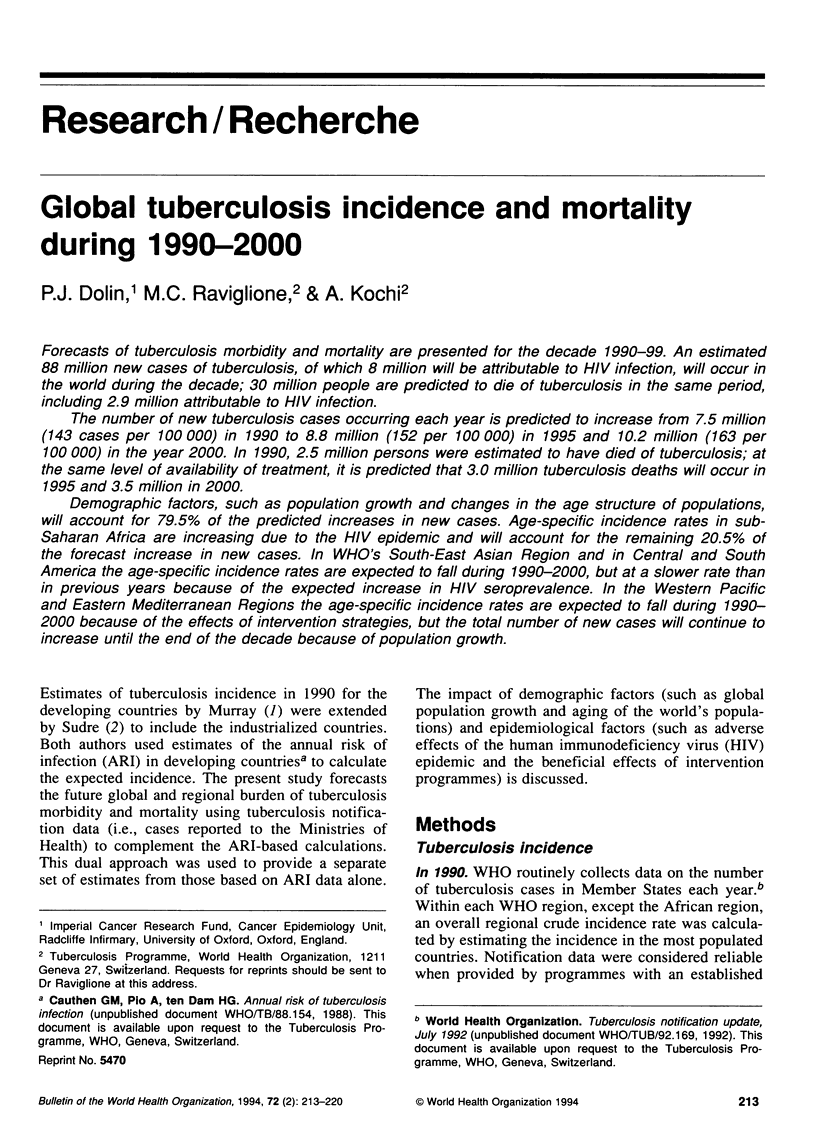Abstract
Forecasts of tuberculosis morbidity and mortality are presented for the decade 1990-99. An estimated 88 million new cases of tuberculosis, of which 8 million will be attributable to HIV infection, will occur in the world during the decade; 30 million people are predicted to die of tuberculosis in the same period, including 2.9 million attributable to HIV infection. The number of new tuberculosis cases occurring each year is predicted to increase from 7.5 million (143 cases per 100,000) in 1990 to 8.8 million (152 per 100,000) in 1995 and 10.2 million (163 per 100,000) in the year 2000. In 1990, 2.5 million persons were estimated to have died of tuberculosis; at the same level of availability of treatment, it is predicted that 3.0 million tuberculosis deaths will occur in 1995 and 3.5 million in 2000. Demographic factors, such as population growth and changes in the age structure of populations, will account for 79.5% of the predicted increases in new cases. Age-specific incidence rates in sub-Saharan Africa are increasing due to the HIV epidemic and will account for the remaining 20.5% of the forecast increase in new cases. In WHO's South-East Asian Region and in Central and South America the age-specific incidence rates are expected to fall during 1990-2000, but at a slower rate than in previous years because of the expected increase in HIV seroprevalence.(ABSTRACT TRUNCATED AT 250 WORDS)
Full text
PDF







Selected References
These references are in PubMed. This may not be the complete list of references from this article.
- Humphries M. J., Byfield S. P., Darbyshire J. H., Davies P. D., Nunn A. J., Citron K. M., Fox W. Deaths occurring in newly notified patients with pulmonary tuberculosis in England and Wales. Br J Dis Chest. 1984 Apr;78(2):149–158. [PubMed] [Google Scholar]
- Murray C. J., DeJonghe E., Chum H. J., Nyangulu D. S., Salomao A., Styblo K. Cost effectiveness of chemotherapy for pulmonary tuberculosis in three sub-Saharan African countries. Lancet. 1991 Nov 23;338(8778):1305–1308. doi: 10.1016/0140-6736(91)92600-7. [DOI] [PubMed] [Google Scholar]
- Narain J. P., Raviglione M. C., Kochi A. HIV-associated tuberculosis in developing countries: epidemiology and strategies for prevention. Tuber Lung Dis. 1992 Dec;73(6):311–321. doi: 10.1016/0962-8479(92)90033-G. [DOI] [PubMed] [Google Scholar]
- Raviglione M. C., Sudre P., Rieder H. L., Spinaci S., Kochi A. Secular trends of tuberculosis in western Europe. Bull World Health Organ. 1993;71(3-4):297–306. [PMC free article] [PubMed] [Google Scholar]
- Springett V. H. Ten-year results during the introduction of chemotherapy for tuberculosis. Tubercle. 1971 Jun;52(2):73–87. doi: 10.1016/0041-3879(71)90015-8. [DOI] [PubMed] [Google Scholar]
- Styblo K. The impact of HIV infection on the global epidemiology of tuberculosis. Bull Int Union Tuberc Lung Dis. 1991 Mar;66(1):27–32. [PubMed] [Google Scholar]
- Sudre P., ten Dam G., Kochi A. Tuberculosis: a global overview of the situation today. Bull World Health Organ. 1992;70(2):149–159. [PMC free article] [PubMed] [Google Scholar]


